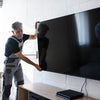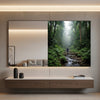Gaming Den Setup Guide: TV vs Monitor, Cable management, and Lighting Ideas

Sure, you could park your console in any old room and call it a gaming den — but you’re not just any old gamer, are you?
This is your castle, your getaway, your base camp. This is Ground Control. And it’s gotta be cool.
You’re in the right place. This guide addresses the five main aspects of gaming den design, including:
-
Choosing between a TV or a monitor
-
Technical essentials
-
Game room ergonomics
-
Cable management
-
Lighting and ambiance
Build a gaming den that’s both immersive and comfortable — and worthy of the designation!
TV vs monitor: Which is better?
A TV offers a larger screen and couch‑friendly gaming, making split‑screen adventures and movie nights more fun. Modern gaming TVs now support variable refresh rates and AMD FreeSync, so screen tearing is less of an issue.
However, monitors typically have faster response times (1 ms or less) and higher refresh rates, which is vital if you play competitively.
|
Feature |
Gaming TV |
Gaming monitor |
|
Screen size |
48–85 inches; immersive couch gaming |
24–42 inches; suited to desk setups |
|
Refresh rate |
60–120 Hz; many now support 120 Hz |
120–240 Hz; ideal for fast shooters |
|
Response time |
4–8 ms; improved on OLED models |
1 ms or lower, reducing motion blur |
|
Connectivity |
HDMI 2.1 for 4K @ 120 Hz; often includes ARC/eARC |
HDMI 2.1 or DisplayPort; may lack ARC |
|
Use case |
Casual and cinematic gaming; couch co‑op |
Competitive gaming; multi‑tasking with PC |
MantelMount perspective
-
Choose a TV if you value size and cinematic immersion
-
Choose a monitor if you need speed and sit close to your screen
2. Technical essentials: HDMI 2.1 and specs
New consoles like PS5 and Xbox Series X output 4K at 120 frames per second, but only if your display supports HDMI 2.1. Without it, you’re limited to 4K @ 60 Hz.
Experts recommend:
-
When shopping for a display, look for HDMI 2.1 ports, variable refresh rate (VRR) and low input lag
-
For competitive gamers, a 144‑Hz monitor with 1 ms response time ensures fluid motion and crisp visuals
3. Creating an ergonomic desk setup
We all know the aches and pains of a long gaming session, making comfort critical for your gaming den. Four things to consider:
-
Invest in a height‑adjustable ergonomic gaming chair that lets you recline, tilt and raise/lower the seat
-
Set your monitor so the top third of the screen is at eye-level and keep the screen about an arm’s length away
-
Regularly change posture, use a footrest to help with circulation and positioning, and for console gaming on a TV, pair a low‑profile couch with lumbar cushions
4. Cable management: There’s a plan for that
A tangle of wires ruins the look of any gaming space. Follow the five steps of gaming room cable management:
-
Plan your layout. Decide where your PC, console, router and power strips will sit.
-
Sort by function. Separate power cables, data cables and controller leads.
-
Use sleeves or Velcro ties. Gather cables into sleeves to keep them tidy.
-
Route them behind the desk (or whatever your gaming desk setup is). Run cables along the back and underside of your desk; use adhesive clips.
-
Install a cable tray. Mount a tray beneath the desk to hold power strips and excess length.
Even better: Mount your PC under the desk, use wireless mice and keyboards, and attach your monitor to an arm.
5. Lighting and ambiance
Add RGB LED lighting strips behind your desk or TV to create a glow — not only does it look cool, but the glow helps reduce eye strain.
You can also use bias lighting behind monitors to improve contrast.
Acoustic panels and a plush rug dampen echoes, while LED Nanoleaf panels or posters personalize the space.
Try pull down TV mounts for the ultimate experience
Designing a gaming den means balancing performance, comfort and aesthetics. MantelMount offers pull down mounts and accessories that allow gamers to lower their TV to proper eye level and swivel it left or right for the perfect viewing/gaming angle. This makes for an unmatched gaming experience. Compare MantelMounts today.
Frequently asked questions
Should I use a TV or monitor for console gaming?
- Choose a TV if you value size and cinematic immersion; choose a monitor if you need speed and sit close to your screen.
How can I manage cables in my gaming setup?
- Plan your layout, sort cables, bundle them into sleeves, route them behind your desk and use a cable tray.
Do ergonomic gaming chairs improve comfort?
- Yes – chairs with adjustable height, tilt and recline support natural posture changes and reduce fatigue during long gaming sessions.






